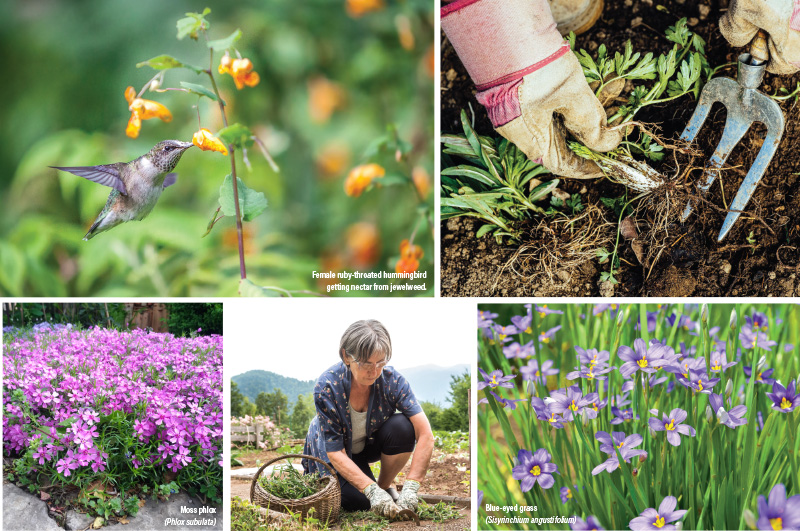A Native Gardener’s Guide to Long-Term Success
By: Lindsey Cline-Shrader
In the early days of my garden, weeding became a kind of ritual. I’d save phone calls for the task—earbuds in, kneeling in the dirt, losing track of time while I yanked out invasive plants and tried to stay ahead of the chaos. There was something satisfying about the rhythm, but I realized I was also giving weeds the perfect conditions to thrive.
Weeds are opportunists. Bare soil, open space, and soil disturbance create the perfect storm for unwanted plants to thrive. Remember you can follow these tips and plan like a pro—but weeding is still part of the garden contract, written in clay and weed seeds.
Learn Your Weeds and Pull Them Early
First, knowing what you’re dealing with can maximize your efforts and help avoid pulling beneficial plants. I once mulched right over jewelweed—now one of my favorite native “weeds” that provides crucial nectar for migrating hummingbirds. While apps aren’t perfect, I’ve found PictureThis highly accurate in identifying common weeds and native lookalikes. Double-check IDs when possible through extension offices, the Virginia Native Plant Society Facebook group, or a field guide. Then you can look up its life cycle, how it spreads, and how to remove it if needed. It’s helpful to know if weed root pieces can resprout, like mugwort, so you know it’s worth extra time to dig it out thoroughly or if a quick pull makes a difference.
Weeds tend to show up most in disturbed areas and during the first few seasons of a new garden.
The key is to pull them while they’re small. At this stage, the plant’s roots haven’t established deeply, nor have they had a chance to set seed.
Weekly walkthroughs in the garden allow you to catch trouble spots early. A five-minute weed pull now can save hours down the road by preventing seed spread or fast-growing rhizomes.

Dense Planting: Crowd Out the Competition
One of the most effective tools in weed mitigation is dense planting. Closely spaced plants shade the ground with their foliage, blocking sunlight from reaching weed seeds and preventing them from germinating. This method mimics plantings found in nature where the ground is always covered with plants (except in mature forests, where deep leaf litter takes over).
Groundcover plants are key—adding color and interest and outcompeting weeds for light, moisture, and nutrients. My favorites are violets, moss phlox for sun (Phlox subulata), woodland phlox for shade (Phlox divaricata), native coral bells (Heuchera Americana), or the many varieties of sedges (Carex spp.). You could also try partridge berry (Mitchella repens), lyre-leaf sage (Salvia lyrata), or blue-eyed grass (Sisyrinchium angustifolium).
Go Easy on the Compost
It’s tempting to add compost or fertilizer to “support your plants,” but richer soil can work against you when it comes to weeds. Many fast-growing weeds thrive in nutrient-rich soils, and research shows that weeds can absorb added nitrogen and phosphorus more quickly than many ornamental or native species, giving them a competitive edge. Native plants are adapted to native soils and grow beautifully without added nutrients.
Say No to Systemic Herbicides
While chemical herbicides promise convenience, systemic products—including pre-emergent granules—can have serious ecological consequences. These chemicals persist in soil, harming beneficial fungi, bacteria, and invertebrates critical to healthy plant growth. Herbicides have been linked to pollinator decline, affecting bees and butterflies that rely on garden plants for food. A new study published in Science magazine recently showed that butterfly populations in the US are down 22 percent in the last 20 years.
Organic methods call for time and planning, but they protect the biodiversity we rely on for pollination and pest control.
A Living Solution to a Persistent Problem
Mulching and pulling sprouts early help beat the weeds while your ground covers fill in the gaps.
That early attention can stave off the July jungle, giving your plants time to fill in before invasive plants gain ground.
I still take calls from the garden with my favorite weeding tool in hand—because some things, like death, taxes, and weeds, are just part of life. But with the right approach, there’s a lot less of it. The goal isn’t perfection—it’s balance. With the right approach, the weeding gets easier, the soil gets healthier, and the garden starts to take care of itself.
What to Pull & What to Let Be
A quick guide to common weeds in Central Virginia
Japanese Stiltgrass
(Microstegium vimineum)
An aggressive annual grass that spreads by seed. Smother with mulch or wood chips in early spring and densely plant over. Mow once in late summer, just before flowering. Cut low to remove the hidden cleistogamous (self-pollinating) flowers tucked in at the base of the leaves.
Creeping Charlie
(Glechoma hederacea)
A low-growing, creeping ivy that thrives in disturbed, shady lawns. Suppress it with healthy plant cover and regular mowing.
Mugwort
(Artemisia vulgaris)
A fast-spreading perennial by rhizomes.
Mow before seeds mature in summer to prevent spread. Pull young plants in spring before rhizomes develop. Smother with landscape fabric, and stabilize bare soil to reduce future growth.
Better Left Alone (or Tolerated):
Native Strawberry
(Fragaria virginiana)
Often mistaken for a weed, this spreading ground cover feeds bees and birds and helps stabilize soil in sunny or partly shaded spots.
Violets
(Viola spp.)
Native, early-spring bloomers that spread easily. While not everyone wants them in their lawn, they’re great for pollinators and ground cover in shady spots.










